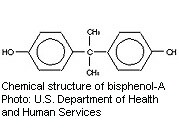
FRIDAY, March 1 (HealthDay News) — Children exposed to the chemical bisphenol A (BPA) may run a higher risk of developing asthma, a new study suggests.
BPA is used in many plastic containers and in the linings of metal cans that hold food. It’s even been found in store check-out receipts using thermal paper. The chemical has been previously linked to a number of health concerns, including breathing problems, obesity, increased blood sugar levels and behavioral issues, the researchers noted.
“As in all such studies, what we see is an association, not necessarily causation, but our finding suggests that BPA exposure during childhood may increase the risk of asthma,” said lead researcher Dr. Kathleen Donohue, an assistant professor of medicine at Columbia University College of Physicians and Surgeons, in New York City.
“Asthma prevalence increased over the past 30 years, which suggests that some as-yet-undiscovered environmental exposures may be implicated,” she said.
“Our study suggests that BPA may be an important and understudied environmental risk factor for child asthma. What’s important is that we are observing increased risk of wheeze and asthma at fairly routine, low doses of exposure to BPA,” added Donohue, who is also an investigator with Columbia’s Center for Children’s Environmental Health.
The report was published in the March issue of the Journal of Allergy and Clinical Immunology.
To determine the effect of BPA on young children, the investigators followed 568 women who took part in a study on mothers, newborns and environmental exposures.
Donohue’s team measured levels of a form of BPA that’s found in urine after exposure to the chemical. They began these measurements during the third trimester of pregnancy and when the children were 3, 5 and 7 years old.
Each time the researchers checked, 90 percent of the children had BPA in their bodies, which is in line with earlier research, Donohue said.
They also found children exposed to BPA after birth had an increased risk of wheezing and asthma. This finding remained even after the researchers took secondhand smoke and other factors linked to asthma into account.
However, Donohue’s group found no link between the risk for asthma and exposure to BPA during the third trimester.
That finding runs counter to a previous study that showed exposure to BPA during the second trimester was associated with an increased risk for asthma, the researchers noted.
The biological connections between BPA and asthma aren’t clear and not every child exposed to the chemical is destined to develop asthma, the researchers say. It might have to do with BPA’s effect on the immune system, but that’s only a guess, Donohue said.
One expert isn’t convinced that BPA is really connected to the risk for asthma.
“You cannot say it’s a cause — it’s an association. It doesn’t mean the chemical is causing asthma,” said Dr. Claudia Fernandez, a pediatric pulmonologist at Miami Children’s Hospital.
“I would not recommend that my patients avoid the chemical based on this article,” she added.
The study acknowledged several limitations, including finding only a “modest” association between BPA concentrations and participants’ wheezing and asthma.
Because of the potential health risk, however, there has been pressure on the federal government to ban the chemical, especially in food containers. In July 2012, the U.S. Food and Drug Administration banned BPA in baby bottles and sippy cups.
Another expert weighed in on the possible connection between the chemical and asthma.
“Certainly, we know there are environmental reasons for asthma, including secondhand smoke, ” said Dr. Len Horovitz, a pulmonary specialist at Lenox Hill Hospital, in New York City.
As for BPA, “it is really unclear what the mechanism is, but it seems clear there really is mechanism,” he added.
Horovitz said that people should avoid exposure to BPA as best they can. “Stop using number 3 and number 7 plastics, use more glass containers, more metal containers and don’t touch store receipts,” he said.
The U.S. National Institute of Environmental Health Sciences also recommends avoiding plastic containers numbers 3 and 7, eating less canned food and choosing glass, porcelain or stainless steel containers, especially for hot food and liquids.
More information
For more about asthma, visit the U.S. National Library of Medicine.

